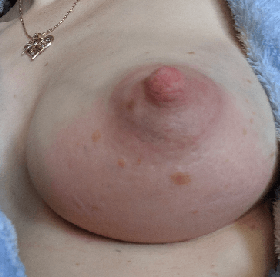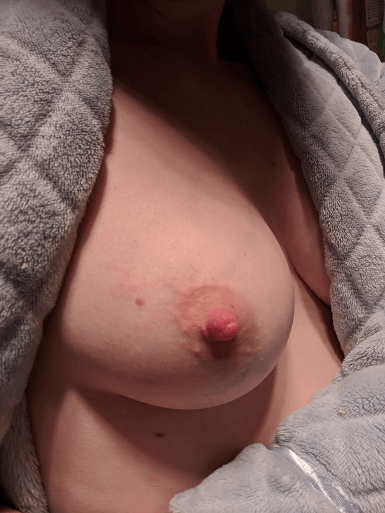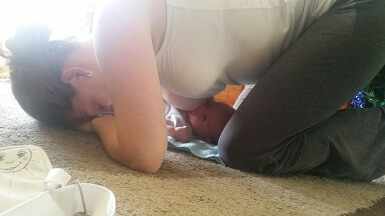Blocked Milk Ducts, blebs and mastitis – what, why and how?
“What are blocked milk ducts?” I hear you say! Or, perhaps you’re here because you’re currently breastfeeding and have found a lump, pain or redness in your breast. It can feel really overwhelming and daunting knowing what to do to manage pain and/or breast lumps when breastfeeding! Hopefully by the end of this article you’ll have plenty of ideas of things to try.
Milk ducts are essentially tiny, interlaced tubes running from our alveoli (milk producing, tiny balloon-like structures) to and through our nipples. Sometimes inflammation can occur in the breast which causes added pressure on and around milk ducts and a consequent narrowing of the milk ducts. This can result in a lump, pain, firmness, redness and if not quickly treated, can escalate to mastitis. There are many factors that can impact the likelihood of experiencing blocked ducts or mastitis – milk supply, the milk microbiome, medical and physical factors.
Blocked Milk Ducts, blebs and mastitis – The causes…
There are a variety of reasons milk ducts can become ‘blocked’ (i.e. narrowed because of surrounding inflammation and congestion). These include (and possibly are not limited to!):
- Latch not quite right – A well latched baby will milk the breast effectively, ‘flushing’ the milk ducts at each feed and enabling good lymphatic drainage and consequent prevention of inflammation.
- Large gaps between feeds – These can result in localised oedema (fluid retention) and engorgement and consequently blockages or mastitis.
- Pressure on or damage to the breasts – For some women, wearing a singlet or crop is enough pressure to prevent adequate milk removal and result in blockages! A change in bra or clothing, sleeping on your tummy or damage to the breast can lead to blockages too.
- Damage to the nipple – Any cracks, grazes, scabs, bites and/or infections can potentially prevent the milk flowing from the nipple. However, it is likely that if there is damage, that is an indication of latch not being right (point 1).
- Difficulties getting a let down and/or stress – The let down or milk ejection reflex is when oxytocin release causes contraction of myoepithelial cells surrounding the alveoli (where milk resides). This contraction essentially ‘squeezes’ milk out of the alveoli, enabling the milk to flow through the milk ducts to your baby. Some mums experience a tingling or full feeling to their breasts, will feel really thirsty or have to take a big, deep breath. Others only notice the let down based on a change in baby’s sucking pattern (from suck-suck to the rhythmic suck-swallow) or milk flowing into a pump. Distracted babies and tense or stressed mums can inhibit the milk ejection reflex. You can stimulate this reflex using warmth before and during the feed, gentle massage (always gentle!), focusing on baby (or photos of bub), taking big breaths, or focusing on letting the milk flow.
Other potential causes less often recognised
- Diet – Avoid eating lots of processed, fatty or sugary foods to help reduce inflammation in the body (and breasts). While no evidence exists that specific foods cause mastitis, inflammatory foods can impact the underlying health and microbiome of the mum and consequently inflammation within the body. Remember mastitis is inflammation of the mammary gland.
- Run down mum – Some women notice being run down or not getting enough rest (laughable with a baby!) predisposes them to inflammation and consequent compression of milk ducts and ‘blockages’.
- Vasospasm – Vasospasm is the sudden contraction of blood vessels. When it happens in our breasts it can restrict the flow of milk from the nipple causing (you guessed it!) blockages. Using warmth before, during and after feeds, ensuring you’re in a warm space and away from a breeze/air conditioner can help reduce vasospasm.
Treatment of blocked milk ducts
Physical treatment options
The Academy Of Breastfeeding Medicine have recently updated their mastitis protocol, and it includes:
- Feed as usual – Milk supply works on a supply = demand situation, so the more milk taken from the breast the more milk you’ll create! Unfortunately, past recommendations to feed/pump more frequently to ‘clear the duct’ don’t take into account the actual cause of mastitis; inflammation and narrowing of milk ducts. Consequently, it is now suggested that actually allowing milk supply on the affected breast to ‘down-regulate’ will facilitate less inflammation and easier milk removal. As such, feed as usual, don’t pump on top of what baby requires and focus on a comfortable latch for each feed (there is no evidence that dangle feeding or pointing baby’s chin towards the lump will help and it could potentially cause a worsened latch).
- Consider feeding the opposite breast first (contralaterally) – It used to be suggested to feed from the affected breast first, but more recently it has been thought that by feeding on the other breast first, enabling a ‘down-regulating’ of milk supply in the affected breast, this might actually be more beneficial in the resolution of mastitis.
- Minimise usage of breast pumps and nipple shields – Breast pumps don’t remove milk from the breast as effectively as a baby will. Additionally, they don’t allow the exchange of bacteria from the breast to baby’s mouth and vice versa. Likewise, using nipple shields prevents milk being removed effectively and reduces bacterial movement, so should also be avoided as much as possible.
- Wear supportive bra – It has been noted that breasts are highly vascular and consequently require support to avoid surrounding pain and swelling.
- Avoid deep massage – Deep massage has long been used as a method for treatment of mastitis with little to no evidence to support it. Deep massage causes increased inflammation, oedema and potentially injury to the breast.
- Lympathic Massage (GENTLY) – Massage reduces breast pain. However, as mentioned above, always go gently if you massage at all and do so with light, sweeping movements. The mastitis protocol from the Academy of Breastfeeding Medicine actually suggests all massage be avoided as ensuring massage doesn’t cause trauma requires extensive training.
- Avoid compresses, soaks and other topical products – There is no evidence supporting their use and they increase the potential for swelling and inflammation.
- Decrease inflammation – While warmth on the breast before and during a feed or pumping can help to encourage the let down and also with comfort of the breast, it does not improve mastitis outcomes. Instead, it is suggested to use ice and anti-inflammatories to reduce inflammation and oedema/swelling. Ice or cold packs can be applied every hour or more frequently as needed.
- Reduce the pressure – Any pressure on the breast from a top, crop bra or otherwise can inhibit milking of the breast. I suggest sitting in your dressing gown and feed, feed, feed. Likewise, try not to sleep on your tummy or in positions with pressure on your breasts.
- Treat nipple blebs (white spots on nipple) – Rather than ‘unroofing’ nipple blebs (i.e. picking the top off and lancing with a sterile needle), it is now suggested that the associated inflammation be treated to enable its resolution. To do this, current research suggests the use of lecithin and 0.1% triamcinolone to reduce inflammation and resolve the bleb.
- Check baby’s latch (or your pump setup) – If bub isn’t latching well, or your pump isn’t quite right for you, this influences milking of the breast. Give an IBCLC a call to assess this, or contact me!
- Therapeutic ultrasound – The key is to reduce inflammation! Therapeutic ultrasound apparently does this whilst also dilating milk ducts. Many women’s health physios offer therapeutic ultrasound and it is suggested the treatment be utilised daily with a setting of 1 MHz, intensity 2.0W/cm2 for 5 minutes.
- Consider probiotics and reserve antibiotics for infectious mastitis – It’s no secret we are dealing with an increase in antibiotic resistance and additionally, for inflammatory mastitis, antibiotics are not necessary. Probiotics (discussed below) may be an alternative to prophylactic antibiotic treatment with cases of mastitis.
Other options (these are sometimes a little harder to arrange!)…
- Rest – Rest not just yourself (yes, go to bed!) but also your breasts! Constantly feeding and pumping can cause swelling, bruising and/or localised oedema in your breast tissue. So feed and latch well, but give yourself breaks in between feeds to recover too.
- Eat well – Cut out the crap to reduce inflammation (I know it’s hard on no sleep!). Processed foods, dairy, sugar and gluten (and others) increase inflammation in the body.
- Acupuncture – In dairy cattle, acupuncture reduces the incidence of mastitis (and can increase milk supply). Low level research supports the same effect in women.
- Cabbage leaves! Or cold compresses – After the feed, using cold cabbage leaves or compresses helps reduce inflammation, pain and hardness of the breasts.
- Drink lots of water – Staying well hydrated is important, especially if you end up with a temperature or fever! So drink lots of water, often, to support your body.
- Myofascial release – This is one that isn’t often suggested, but can be SO amazing! I encourage you to give it a go! By releasing fascia restrictions the milk ducts are free to flow. For a discussion of these techniques from an Osteopath, check out this link!
Supplements and other things that might help…
The research is limited in this area. If there is a highlighted, linked item it’s because there is some research to support it. I include all methods I know of as anecdotes can be helpful too! Sometimes anecdotes are just responses that we don’t yet have data to back up; worth keeping in your arsenal.
- Lecithin – Many IBCLCs and women note that lecithin reduces the ‘stickiness’ of milk, helping it flow freely, and it in another study it seems it may enable fat to remain in milk. There is no research to support ‘reduced stickiness’ of breastmilk to my knowledge.
- Probiotics – This is a review on the research behind probiotic use for mastitis; we need more research. However, some studies report a correlation between probiotic use and reduction or prevention of mastitis. If you’re going down this route Lactobacillus fermentum and L. salivarius are the bacteria you need.
- Magnesium, calcium and Nifedipine – Magnesium, calcium and Nifedipine reduce the incidence of vasospasm, a causative factor for blockages (see above). There is no research on magnesium use for women without vasospasm, so it’s unknown whether it would help.
- Vitamin B6, Fish Oil and Nifedipine – These are again supplements or medications that can reduce the incidence of vasospasm, a causative factor for blockages.
- Ibuprofin – Ibuprofin reduces inflammation in the body (and breast tissue), reducing pressure on milk ducts. This can allow the milk to flow more easily.
- Magnesium sulfate soak – Magnesium sulfate (epsom salts) soaks supposedly reduce inflammation and get the milk flowing. Some research supports its use but the Academy of Breastfeeding Medicine warn against its use.
- Homeopathics – Many women swear by Belladonna, Phytolacca and Poke Root for relieving mastitis. I suggest speaking with a homeopath/herbalist directly if you’d like to use these therapies.
What about recurring blocked milk ducts!?
Recurring blockages, regardless of the type, are painful and so upsetting! If you can’t find the cause and you’ve tried the ideas above, seek additional help. Please reach out to an International Board Certified Lactation Consultant for help or contact me for a lactation consult!
Mastitis? What is it? What do I do?
Mastitis is breast inflammation, not infection, though it can sometimes occur due to an infective agent (typically the bacteria, Staphylococcus aureus). The key difference between mastitis and a blocked milk duct is the systemic signs of illness, including:
- Headache or body aches
- Fever
- Fatigue
- Feeling ill
- Shivers/lack of temperature control
Inflammatory mastitis is treatable as described above, without antibiotics. However, if you find you’re struggling to treat and/or you’ve had systemic illness signs for 24 hours without improvement, it’s worth following up. Many GPs will prescribe antibiotics for mastitis. While sometimes useful, clearing the inflammation is key and still necessary. The reason GPs are cautious and prescribe antibiotics is to avoid mastitis developing into a breast abscess. These are uncommon, but it’s worth being aware that they do occur in 3-10% of mastitis cases, particularly when mastitis isn’t treated appropriately (like with firm massage). Some GPs are really knowledgeable about breastfeeding and will give fantastic advice, but this isn’t the common experience. Please reach out to an International Board Certified Lactation Consultant for help or contact me for a lactation consult if you need!
What happens after I clear the blockage?
Just keep on feeding! Some women will notice a decrease in milk supply following mastitis, which makes sense if milk has had a harder time flowing from the breast for a time. It will rectify over time through frequent, responsive breastfeeding or pumping. Vice versa, if a woman has been feeding and pumping frequently she may notice an up-regulation of supply. If this is the case for you, progressively cut back feeds/pumping until it is just as much as your baby needs. You can use cold cabbage leaves and ice as noted above to help curb the milk supply and reduce any engorgement/inflammation too. I typically suggest listening to your breasts and pumping or hand expressing whenever you feel engorgement or lumpiness to the breasts.
Reach out for help!
If you need any help at all, please let me know! I have been assisting mums through issues, like mastitis for years, and am an IBCLC. Furthermore, I have personal experience with navigating the hurdles of recurring mastitis. I’m here for you!




